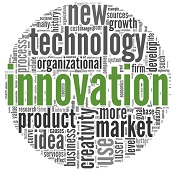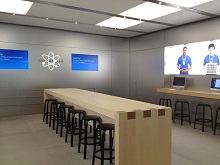2.5 Innovation or Bust II
 Apple continues to push innovation that moves the technology field forward. Apple introduced retina displays on their iPhones, iPads, and MacBooks in 2012. The retina display is a high definition screen without pixels. On the 13" MacBook laptop, there are four million pixels on the screen. Text is sharp and colors realistic. Photographers, web designers, graphic designers, and others who benefit from the quality screens lined up to purchase new devices. Apple also pushed the use of USB3 and Thunderbolt connections that increased the speed of transferring data. Apple was also the first computer manufacturer to introduce Flash memory storage in place of traditional hard drives. The Flash memory storage is significantly smaller, has no moving parts and starts up immediately. The downside (for now) is that these chips have a smaller storage capacity and cost more than traditional hard drives.
Apple continues to push innovation that moves the technology field forward. Apple introduced retina displays on their iPhones, iPads, and MacBooks in 2012. The retina display is a high definition screen without pixels. On the 13" MacBook laptop, there are four million pixels on the screen. Text is sharp and colors realistic. Photographers, web designers, graphic designers, and others who benefit from the quality screens lined up to purchase new devices. Apple also pushed the use of USB3 and Thunderbolt connections that increased the speed of transferring data. Apple was also the first computer manufacturer to introduce Flash memory storage in place of traditional hard drives. The Flash memory storage is significantly smaller, has no moving parts and starts up immediately. The downside (for now) is that these chips have a smaller storage capacity and cost more than traditional hard drives.
5. WOW the Consumer, Over and Over Again
The Macintosh was never a huge seller: in fact, the cheaper PC computers using Microsoft Windows have outsold the Macs by a large margin. The small user base is very loyal to the Apple platform and the products have attracted somewhat of a cult following. The design team and engineers at Apple did not rest on their laurels. Apple later introduced such innovative products as the iPod in 2001, the dynamic iPhone in 2007 (hard to believe that the smart phone is only 7 years old) and the iPad tablet in 2010. Although Steve Jobs is no longer with us, the design team and engineers that Steve installed continue to push the envelope and develop new technology and products.
6. Own the Ecosystem, Deliver World Class Customer Service and They Will Come … in Droves with Wheelbarrows of $
 Another way that Apple changed computing was the innovative approach to doing business. Apple had been selling their products alongside their competitors at Best Buy, Target, Comp USA, and other retailers. Apple decided that they would have more success if they controlled the environment where the products were sold. In 2001, Apple opened the first Apple stores in McLean, Virginia and Glendale, California. The Apple store was different. It was meticulously designed to maximize the shopping experience and looked like a high-end showroom with ample use of glass, stainless steel, and handcrafted wood tables. There were play areas for children, working computers with internet connections, and most of all, the Genius Bar in the back of the store where you could bring your computer in for repair and to talk to a technician. The mobile devices, iPhones, iPads and iPods are diagnosed at the store while you waited. There are also tables in the back for workshops and training sessions provided free of charge to educate the consumers on the best use of the products.
Another way that Apple changed computing was the innovative approach to doing business. Apple had been selling their products alongside their competitors at Best Buy, Target, Comp USA, and other retailers. Apple decided that they would have more success if they controlled the environment where the products were sold. In 2001, Apple opened the first Apple stores in McLean, Virginia and Glendale, California. The Apple store was different. It was meticulously designed to maximize the shopping experience and looked like a high-end showroom with ample use of glass, stainless steel, and handcrafted wood tables. There were play areas for children, working computers with internet connections, and most of all, the Genius Bar in the back of the store where you could bring your computer in for repair and to talk to a technician. The mobile devices, iPhones, iPads and iPods are diagnosed at the store while you waited. There are also tables in the back for workshops and training sessions provided free of charge to educate the consumers on the best use of the products.
Since Apple stores are usually very busy, the specialists carry a device called the EasyPay. They can ring up your purchase from a hand-held device and send you on your way. No waiting in long lines at a cash register. Cash and checks are also accepted at the tables located throughout the store, where cash drawers pop out from the sides. Your receipt can be printed from a printer hidden under the tables or sent to your e-mail. The mobile EasyPay system was a huge success and has been copied by Gap and Old Navy, among others.
For business clients, Apple has developed a business discount program that rewards repeat business. Every Apple store has a business team that is trained on the discount programs and services that help business clients use the technology. The Joint Venture program is a training and service program that transfers data from old to new computers, provides training on software and hardware solutions and gives members access to the Genius Bar with no reservations or waiting. Computer buyers are offered a one-to-one program for $99 that allows you to schedule individual training sessions on a variety of topics, transfer data, assistance with setting up your e-mail and establishing your iCloud accounts.
7.5 Bonus Strategy
You run a business. You accept payments. You take checks – awesome. You do not enjoy the risk associated with taking checks from strangers, even when everything seems legitimate. What to do? Consider a check processing company that offers check verification or check guarantee, a safety net if you will, to guard against the potential of returned checks. What’s the difference between the two services and how will either benefit you and your business? We’re glad you asked. Click below for our on-demand webinar, Check Verification vs. Check Guarantee, that in 9 minutes is sure to help you figure out if verification or guarantee are right for your business.



